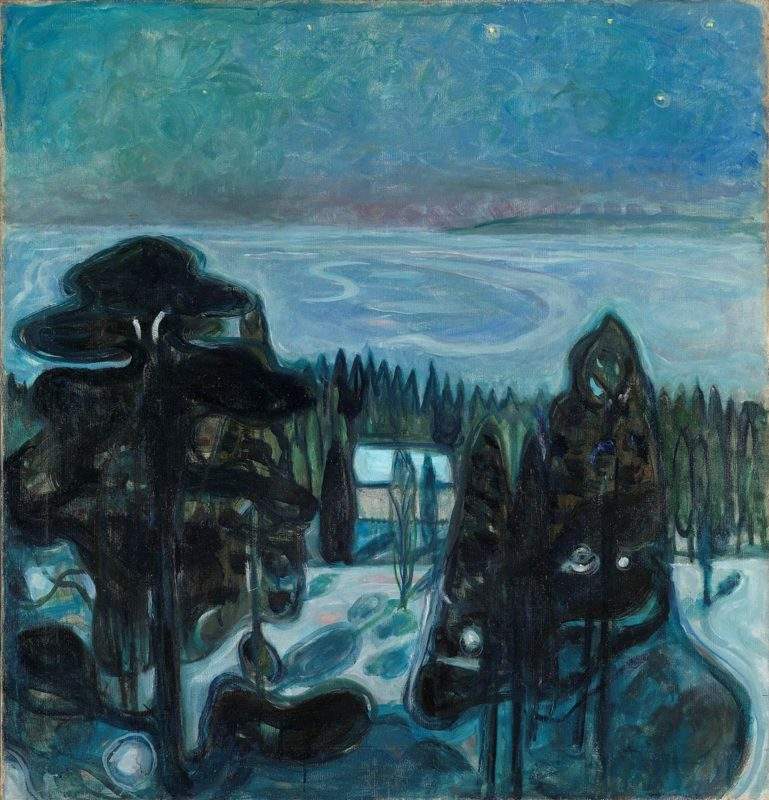How Did Friedrich Nietzsche Influence Art?
Published by Reblogs - Credits in Posts,

German philosopher Friedrich Nietzsche was one of the most important voices of the 19th century. But did you know his ideas spilled out into the arts? He was a keen supporter of artistic practice, believing it had a vital role to play in the development of a civilized society. As such, his ideas went on to have a significant influence across various arts and cultural practices. We outline just some of the ways Nietzsche’s philosophy impacted ways of thinking about, seeing, and making art in the centuries that followed.
Friedrich Nietzsche Considered Art to be the Highest Expression of Life
 Leon Spilliaert, Young Woman on a Stool, 1909, via The Evening Standard
Leon Spilliaert, Young Woman on a Stool, 1909, via The Evening Standard
From early in his career, Nietzsche described art as the highest form of self-expression. He also believed artists were among the most noble and revered citizens of society. Nietzsche justified this belief by arguing that artists demonstrated high autonomy and a rejection of moral obedience and societal norms. He even described artists as true rebels who were prepared to completely reject conventions and follow their own true individual path, thus paving the way towards an unexpected new future.
Nietzsche was particularly critical of societal conformity, instead supporting individual agency and personal freedom. These attitudes were inspirational for a huge range of artists, offering legitimacy for their unconventional and often hugely challenging life choices. We can see the influence of these ideas on a range of different artists in the late 19th and early 20th century, including the eccentric Symbolist painter Leon Spilliaert, who made deeply atmospheric, highly individualist paintings.
Friedrich Nietzsche’s Concept of Order and Chaos Inspired Artists
 Friedrich Nietzsche, The Birth of Tragedy, 1872, via Scribd
Friedrich Nietzsche, The Birth of Tragedy, 1872, via Scribd
Nietzsche’s first published book, titled The Birth of Tragedy, 1872, had a particularly profound influence on generations of creative thinkers. What was it though, that made this book so influential? Nietzsche argued that art was a careful tension between two opposing forces. On the one hand, there was the need for order, restraint and proportion. Nietzsche used the term ‘Apollonian’ to describe this strand of artistic practice. He named this term after Apollo, the Greek god of light and reason.
 Edvard Munch, White Night, 1901, via The National Museum of Art, Architecture and Design, Oslo
Edvard Munch, White Night, 1901, via The National Museum of Art, Architecture and Design, Oslo
On the other hand, Nietzsche also believed there was an erratic, chaotic element to making art which opened up elements of danger and the possibility of complete destruction. He named this strand of art Dionysian, after Dionysus, the Greek god of wine and music, who had inspired a culture of eroticism and indulgence. Through uniting these two opposing forces, Nietzsche argued that artists were able to express both the light and dark aspects of human existence, holding them suspended in a unified state. We see this, for example in Norwegian Symbolist painter Edvard Munch’s landscapes, which capture states of both melancholia and sublime beauty.
Nietzsche’s Greatest Admirers Include Salvador Dali
 Salvador Dali, Illumined Pleasures, 1929, Museum of Modern Art, New York
Salvador Dali, Illumined Pleasures, 1929, Museum of Modern Art, New York
One of Nietzsche’s most outspoken admirers was the Spanish Surrealist painter Salvador Dali. In particular, Dali often spoke about making art that expressed a "Dionysian dream." He also expressed an interest in the two opposing forces of art that come together, echoing Nietzsche’s philosophy. Dali wrote, "That was the great lesson taught by ancient Greece, a lesson that I believe was first revealed to us by Friedrich Nietzsche. Because if it is true that Apollonian spirit in Greece reached the highest universal level, it is even more true that the Dionysian spirit surpassed all excess and all outrage." Dali’s art also demonstrates these two conflicting states, with its high levels of realism, and strange, contorted imagery. Some say Dali even took inspiration for his trademark moustache from Nietzsche!
Edvard Munch and Max Klinger
 Edvard Munch, Portrait of Friedrich Nietzsche, 1906, via Thielska Galleriet
Edvard Munch, Portrait of Friedrich Nietzsche, 1906, via Thielska Galleriet
The early 20th century Norwegian Symbolist painter Edvard Munch was another keen admirer of Nietzsche’s philosophy. Both shared the same fear of loneliness and madness. Although they never actually met, Munch painted a portrait of Nietzsche six years after the philosopher’s death, which demonstrates the spiritual kinship Munch felt with him.
 Max Klinger, Nietzsche Portrait in bronze, 1902, via Ernst von Siemens Kunststiftung
Max Klinger, Nietzsche Portrait in bronze, 1902, via Ernst von Siemens Kunststiftung
Like Munch, German artist Max Klinger avidly read Nietzsche’s philosophy. He applied many of Nietzsche’s ideas around rule-breaking and self-expression to his art, and even made a series of portraits portraying Nietzsche’s distinctive face.
https://www.thecollector.com/how-did-friedrich-nietzsche-influence-art/
